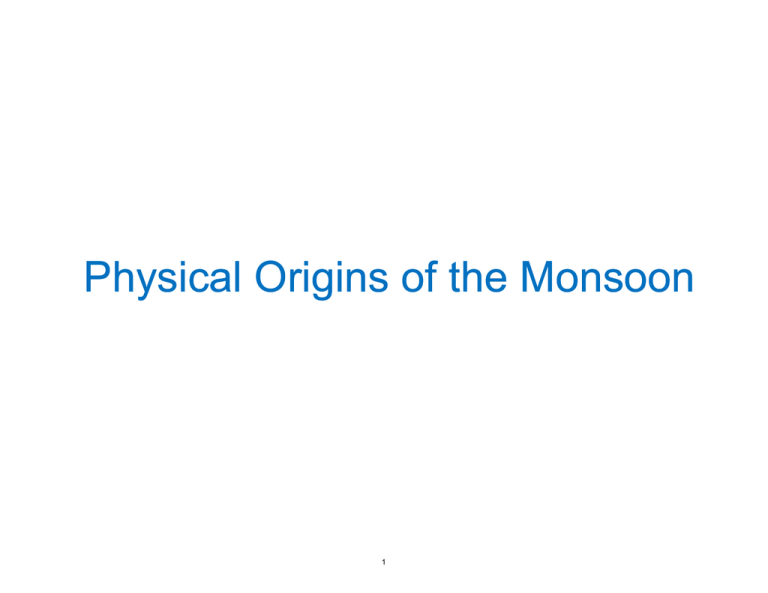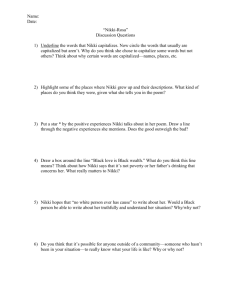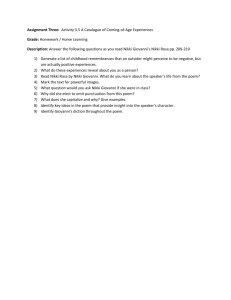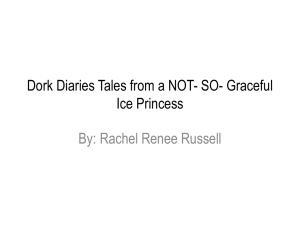Document 13567979
advertisement

Physical Origins of the Monsoon Monsoon 1 See figures on pages 24267-24270 In journal: Molnar, and Emanuel. -RXUQDORI*HRSK\VLFDO5HVHDUFK 104 (1999): 24267-70. 2 July 1 observed 1000 mb sb J/kgK Longitude 3 NCEP Reanalysis PV M PV, M, on 370K 370K, JJull 87 87-90 90 4 Two--D Simulations Two Simulations 5 Off-equatorial forcing in 2D Te [Plumb & Hou, JAS, 1992] 6 Off-equatorial forcing [Plumb & Hou, JAS, 1992] 7 Simple PE Model • • • • • • Only 20 grid columns, N-S High resolution in vertical Convection, radiation, and cloud schemes Land poleward of 12 N (y=6000 km) Slab ocean Annual cycle of insolation 8 9 10 11 12 13 14 15 Absolute angular momentum (shading) and meridional streamfunction (thin contours) for the dry GCM with steady forcing and θm = 15 K (left) at the initial transient peak and (right) after the model achieved a steady state. Thick solid line is the zero absolute vorticity contour. Streamfunction contour interval is 1 × 1010 kg s−1, starting at 0.5 × 1010 kg s−1, with negative contours (denoting clockwise rotation) dashed dashed. Angular momentum contour interval is 0.2 × 109 m2 s−1. 16 As in Fig. 2, but for the dry GCM with seasonally varying forcing, at the time of largest PBL flow. 17 Phase diagram of the PBL flow and the spatial extremum of the equilibrium temperature anomaly for the dry GCM. Solid line is for the run with seasonally varying forcing forcing, with time progressing in the direction of the arrow arrow. The circles connected by the dashed line denote the equilibrated response to steady forcings. 18 As in Fig. 4, but the phase diagram for the moist GCM with strong forcing (θm = 10 K) and wind-independent surface enthalpy fluxes. The dot denotes the model state for which M and are shown in Fig. 7. 19 As in Fig. 4, but the phase diagram for the moist GCM with weak forcing (θm = 1.0 K) R K). Runs (l (left) ft) with ith and d ((right) i ht) without ith t nonlinear li momentum t advection d ti are shown. h The black and gray lines are for runs with and without WISHE, respectively. Dot in (left) denotes the time at which M and are shown in Fig. 9. 20 As in Fig. 7, but for the moist GCM with weak forcing (θ (θm = 1.0 K), at times denoted by the dot in Fig. 8. Runs (left) with and (right) without WISHE are shown (both included nonlinear momentum advection). 21 Phase diagram, for the moist GCM with weak forcing (θm = 1.0 K), of the meridional mean meridional gradient of surface enthalpy fluxes, with the mean taken between the enthalpy flux peak and 10 10°N N, plotted against the SST at 25°N 25 N. The black and gray lines are for runs with and without WISHE, respectively, both with nonlinear momentum advection. 22 23 Model runs (Nikki Prive) MIT model 64S – 64N; 4 degree resolution Moist model with simple lower boundary conditions Ocean: specified SST L d specified Land: ifi d totall surface f hheat fl flux, bbucket k hhydrology d l Moist convection parameterization (Emanuel) “R diati “Radi tion”: Newt N toniian rellaxati tion to t 200K 16N 24 Courtesy of Nikki Prive. Used with permission. 25 2D 3D Courtesy of Nikki Prive. Used with permission. 26 3) Cross-equatorial flow: does threedi dimensionality i lit matter? tt ? 27 Cross-equatorial flow [Pauluis, JAS, 2004] Strong SST gradient across equator Weak SST gradient across equator Shallow boundary layer Deep boundary layer 28 3D 2D Courtesy of Nikki Prive. Used with permission. 29 30 Upper tropospheric PV on = 370/380K and Z on 200/150hPa [Hsu & Pllumb b 1999] 31 Theories of Monsoon Location Location • Plumb and Hou (1992), Emanuel (1995), Zheng ((1998)) – Explained axisymmetric circulation induced by local subtropical forcing • R Rod dwellll and dH Hoski kins (1995) – Rossby waves induce subsidence to the west of the monsoon,,creatin g east-west asyymmetryy • Xie and Saiki (1999) – Hydrological feedbacks limit inland progression of the monsoon • Chou, Neelin, and Su (2001) – Advection of low moist static energy air air, hydrological feedbacks, and Rodwell-Hoskins effect all limit poleward extent of the monsoon 32 Impact of local hb maximum over land E S W v Land N Ocean Subcloud moist static energy, hb Courtesy of Nikki Prive. Used with permission. 33 Resulting meridional circulation and precipitation Poleward moist static energy Courtesy of Nikki Prive. Used with permission. 34 Factors that affect sb • Surface heat fluxes • Evaporation of precipitation in convective downdrafts • Radiative cooling • Entrainment at the top of the subcloud layer • Advection by large-scale flow Circulation may have a strong impact on the subcloud sb distribution through these feedbacks. 35 Observed circulation and subcloud s s b 36 Model Setup South North 16N Over land, the surface forcing is determined by THF THF0 THF() LHF(TS ) SHF(TS ) THF() THF0 THFsin2 ( 0 ) Courtesy of Nikki Prive. Used with permission. 37 2D Monsoon Circulation kg/s Zonal wind m/s 1000 mb h J/kg Precipitation mm/day mm/da Courtesy of Nikki Prive. Used with permission. 38 Monsoon Latitude Courtesy of Nikki Prive. Used with permission. 39 Impact of flow on hb Radiative convective equilibrium In the presence of a meridional circulation Courtesy of Nikki Prive. Used with permission. 40 So what is going on with hb? Courtesy of Nikki Prive. Used with permission. 41 Expand to 3D Courtesy of Nikki Prive. Used with permission. 42 3D Monsoon Circulation k / kg/s Zonal wind m/s 1000 mb h J/kg precipitation mm/day Courtesy of Nikki Prive. Used with permission. 43 1000 mb winds and precipitation 11 m/s Courtesy of Nikki Prive. Used with permission. 44 Monsoon Latitude: 2D vs 3D 3D Courtesy of Nikki Prive. Used with permission. 45 Impact of eddies on subcloud h Courtesy of Nikki Prive. Used with permission. 46 Introduce continental asymmetry asymmetry Courtesy of Nikki Prive. Used with permission. 47 What happened to the monsoon? 11 m/s Courtesy of Nikki Prive. Used with permission. 48 Impact of advection of low hb air air 11 m/s Courtesy of Nikki Prive. Used with permission. 49 Comparison hb distribution distribution 11 m/s Courtesy of Nikki Prive. Used with permission. 50 Subcloud hb with warm ocean ocean 3 m/s Courtesy of Nikki Prive. Used with permission. 51 Remove the source of low hb… 3 m/s Courtesy of Nikki Prive. Used with permission. 52 MIT OpenCourseWare http://ocw.mit.edu 12.811 Tropical Meteorology Spring 2011 For information about citing these materials or our Terms of Use, visit: http://ocw.mit.edu/terms. 53




